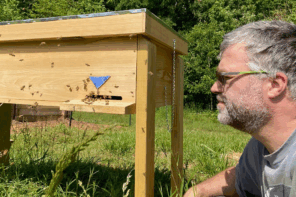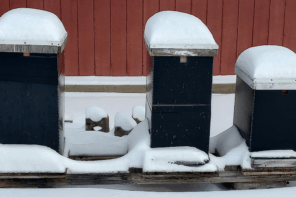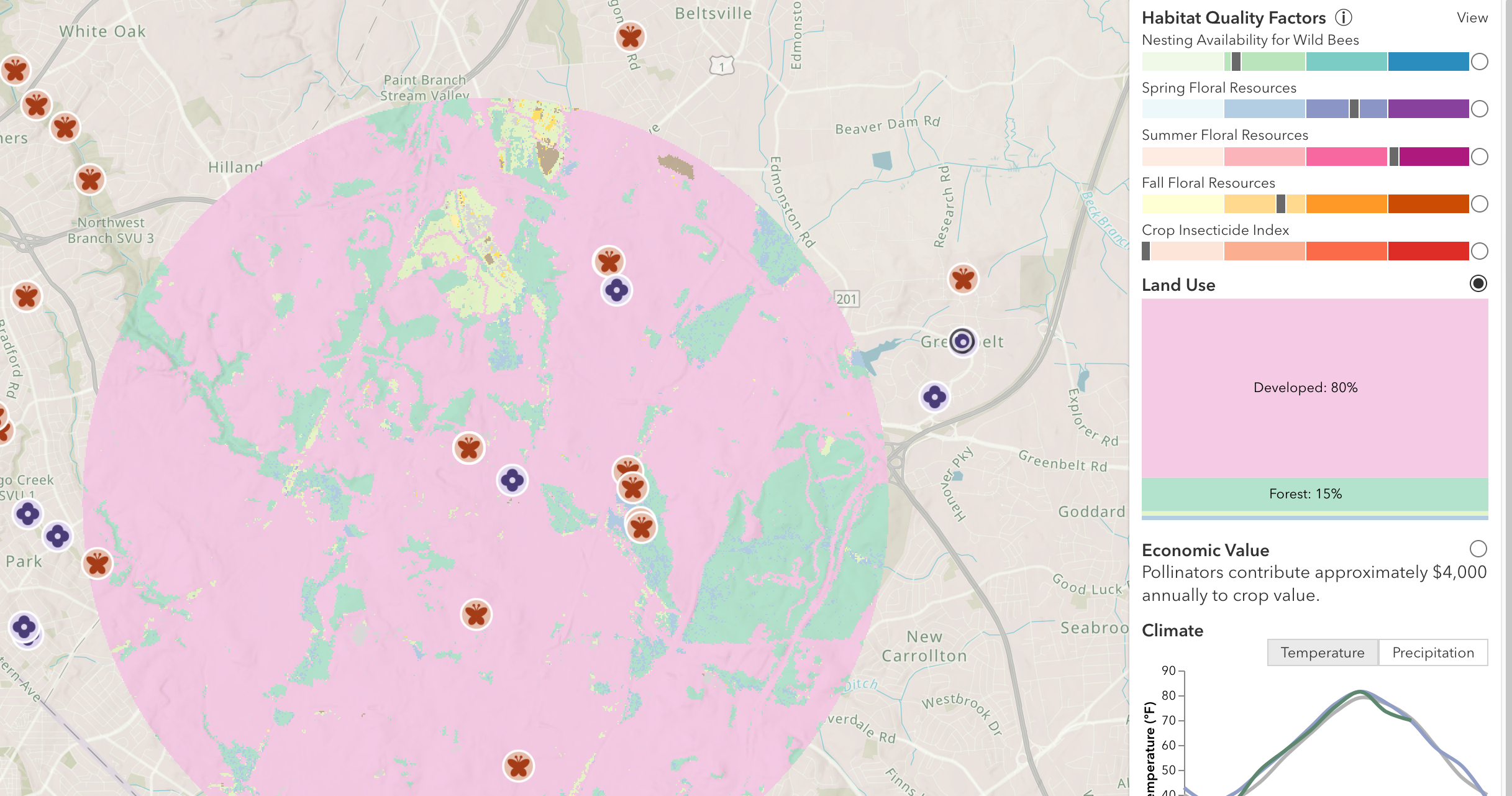By: Jay Heselschwerdt
This article originally appeared in the Spring 2019 issue of BEEKeeping Your First Three Years
America Foulbrood (AFB) is not from America and European Foulbrood (EFB) is not from Europe. It is more about who discovered the AFB and EFB. American scientists found the disease and have classified it as what we know of it today and the same for the European scientists and EFB.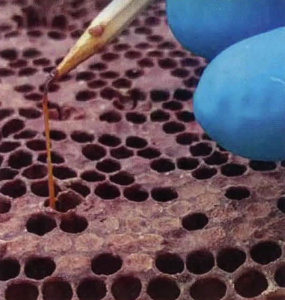
I would like to discuss more about how to keep your bee yard(s) clean and safe from AFB. There are many websites to learn from on the internet. There are also some classes to take on what to look for and that distinct smell of a “chicken house” or dead fish (hence the name “foulbrood”). But, how do you get it and stay away from getting it in your hives? What are the do’s and do not’s of keeping your honey bees and wooden ware safe from it? Why do some states have so many outbreaks and other do not? So many questions for such a small spore (paenibacillus larvae).
So first off let us start at how you get it AFB in your hives. The easiest way is to buy used equipment and the spores are already in the woodenware. Wood has pores and since we only paint the wood on the outside of the hive, the inside of the hive bodies and frames have countless amount of pores to hide in. Even after the bees treat the inside of the wood the spores since have areas to hide and lay in wait. The AFB spores slide inside the pores of the wood and can live there for more than 80 years. Even if you wash it, bleach it, run a torch over it, the spores will survive it. The only way to kill the spores is to burn the hive! If the bees are living in the hive then the bees will need to be killed. Use gasoline and make sure the hive is taped up so none of the honey bees can escape. You should wait till night when all the bees have returned for the night before killing them. Then once all the bees are dead, open the hive to air out the gas. Gas is explosive so be careful before lighting the hive on fire. If the gas is still in the hive when you put fire to it, you will launch the hive into the air. I would not think hot wax and honey raining down on you would be a good thing.
Another way to get AFB is when a hive is declining in population due to the hive being sick and the AFB taking hold. The hive weakens and is able to be robbed from other colonies in that area. Those said colonies could be up to three miles away depending on the time of the season and nectar flow. That one hive can now cause several hives to have the spores as the robbing bees take honey and pollen back to their colony. Three miles contains thousands of acres! That can have a lot of beehives within that acreage.
Drifting can also be a problem with spreading of the spores from one hive to another hive in your bee yard. The adult bee can have the spores in their stomach and still live for a while. The bee can even feed the spores to the larvae in the cells. Which will in turn increasing the depopulation of the hive even faster.
Drones are a very social bee and will check out hives within their area. Once inside the hive a worker may feed the hungry drone. Once the drone is fed and happy, he returns home with AFB in his stomach to spread in his colony.
Your hive tool can transport the spores from hive to hive and from yard to yard if you have multiple yards or help other beekeepers. Your smoker and gloves can also transport the spores. The gloves are in each hive and the propolis (along with the AFB spores) sticks to your gloves and then to the smoker bellows. The smoker is used at each hive and sometimes in multiple yards.
But, the biggest problem of the spores being transferred from one hive to the next is the beekeeper themselves. Everyone is taught to pull frames from the strong hive to place in a weak hive to boast it. Evening out the honey going into Winter by moving frames from hive to the next hive. If a hive dies out just put more bees in it or use that wooden ware somewhere else in the bee yard. It all works fine, until you have AFB then there is trouble.
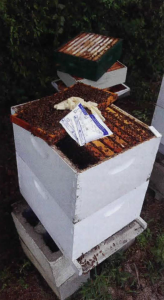 Ok, so we figured out how the spores are transferred around from one hive to another or many. What can you do to limit the amount of transfer of the spores?
Ok, so we figured out how the spores are transferred around from one hive to another or many. What can you do to limit the amount of transfer of the spores?
Do not buy used equipment no matter what the sellers will tell you. The seller says “The bees just left the hive”. Why would the bees just leave the hive? Or they say “The bees just died”. Honey bees just do not die for no reason. Here in Tennessee it is illegal to sell used equipment unless it is boiled in lye water for more than 30 minutes. Then what do you do with the 50 gallons of lye water that was in a barrel large enough to dip one brood box in? That lye water if poured down your sink will eat your pipes and cause a huge plumbing bill. Besides, who has the time to boil each piece for 30 minutes? If you did have the time the wood hive bodies will be useless. You will be able to push your finger though the side of the hive body. It is not worth saving a little money on used equipment if it is killing your bees. Just say “NO” to used equipment.
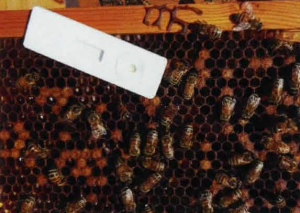
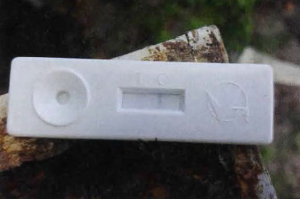 Robbing can be controlled by not feeding at the hive entrance. Or put the entrance feeder all the way to one side of the hive entrance than close up the center of the hive and leave the entrance for the honey bees on the opposite side. Or a better option is to use hive top feeders. Check your hives before the dearth (dry season) comes to your area and see if you need to feed or not. Do not use the community bucket feeder or as I like to call them the community disease spreaders.
Robbing can be controlled by not feeding at the hive entrance. Or put the entrance feeder all the way to one side of the hive entrance than close up the center of the hive and leave the entrance for the honey bees on the opposite side. Or a better option is to use hive top feeders. Check your hives before the dearth (dry season) comes to your area and see if you need to feed or not. Do not use the community bucket feeder or as I like to call them the community disease spreaders.
Drifting can be solved by a few different options in the bee yard. Off set your hives so the wind does not push your honey bees towards the next hive. Paying attention to the wind direction will help you with the bee yard set up. Next you can set up wind blocks between the hives. Another option is to use different shapes on the hive just above the entrance. Honey bees can tell the difference between a circle, square, and triangle for example.
Your hive tool, smoker and gloves can be an easy fix if you have multiple beeyards. Use an outer cover upside down and place a deep hive body in to it. Use another outer cover as a lid and now you have a box to put your hive tool, smoker, and gloves in. Make sure your smoker is out and is not hot before placing into the box for storage. It is cheaper to have a hive tool, smoker and gloves in each bee yard than to burn a hive in each yard because you are not willing to take a little precaution.
If you have one or more bee yards and you see something wrong in the hive then STOP. Do not use the hive tool or smoker in any more hives till you figure out what is going on inside the hive. As far as gloves go, I use the blue nitrile disposable gloves which I can turn inside out and throw away after each inspection. Or if the hive has AFB then the disposable gloves can be burnt with an AFB hive. You can use the leather gloves, but they are hard to clean and could still have spores on them after washing the gloves.
If you help or inspect other people’s hives, use their hive tool and smoker! Only show up at their yard with your bee suit or veil. Yes, you should wear pants also.
So, how to fix the beekeeper and the swapping of frames and boxes between the hives? If the bees die in the hive do not split up the equipment. Repopulate the hive with more bees and see how they do. It just may have been bad genetics and the bees just could not overcome some disease or virus or it could be AFB. This way you will know for sure before possibly spreading the spores around by moving equipment.
Number your boxes and frames and keep records on where that box and/or frames are and go to. “B25” (box25) is at “H3” (hive position 3) and has “F102” (frame 102) out of “B31” at “H4”. This way, if hive four has AFB you know that hive three also needs to be watched for AFB. Now you do not have to get to crazy with keeping records but it helps to at least know that you took a frame out of hive four and put it in hive three.
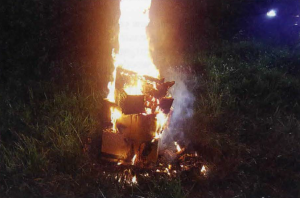 In Tennessee, we will report AFB the same day we find it. As soon as the state apiarist sees it and confirms it (usually the same day or the very next day). We dispatch the bees that evening and burn the hive in place. Then every hive in an eight mile radius is checked for AFB. Tennessee has one of the lowest amounts of AFB cases reported in the USA. Other states will suggest you do a shook swarm by shaking the bees on to new equipment and then see how they do. If the bees have the spores in their stomachs it is just prolonging the end. Plus, it will increase the chance of spreading the spores to more hives and equipment. Also, what happen to the old hive? Did they burn it or return to the honey house to get mixed in and forgotten about? The states that suggest this technique have many more AFB cases each year. If you live in one of those states you may want to help change that practice.
In Tennessee, we will report AFB the same day we find it. As soon as the state apiarist sees it and confirms it (usually the same day or the very next day). We dispatch the bees that evening and burn the hive in place. Then every hive in an eight mile radius is checked for AFB. Tennessee has one of the lowest amounts of AFB cases reported in the USA. Other states will suggest you do a shook swarm by shaking the bees on to new equipment and then see how they do. If the bees have the spores in their stomachs it is just prolonging the end. Plus, it will increase the chance of spreading the spores to more hives and equipment. Also, what happen to the old hive? Did they burn it or return to the honey house to get mixed in and forgotten about? The states that suggest this technique have many more AFB cases each year. If you live in one of those states you may want to help change that practice.
I hope you never see AFB firsthand and if everyone does the above mentioned in their bee yard we can help eliminate AFB. Another thing to remember is that Terramycin does not cure AFB, it only covers up the problem. Once the bees are no longer receiving Terramycin treatments the AFB will take hold and the hive is doomed.








